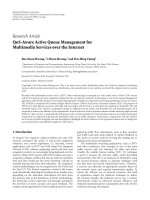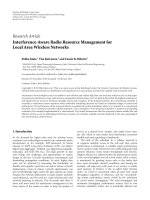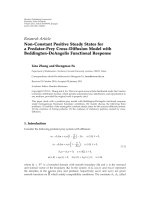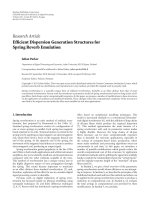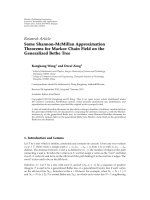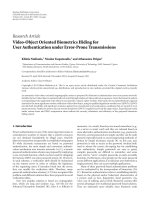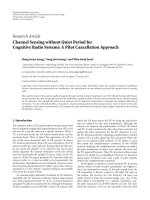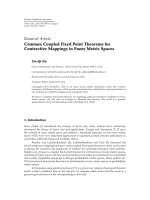Báo cáo hóa học: " Research Article Connectivity-Based Reliable Multicast MAC Protocol for IEEE 802.11 Wireless LANs" doc
Bạn đang xem bản rút gọn của tài liệu. Xem và tải ngay bản đầy đủ của tài liệu tại đây (567.04 KB, 6 trang )
Hindawi Publishing Corporation
EURASIP Journal on Wireless Communications and Networking
Volume 2009, Article ID 968408, 6 pages
doi:10.1155/2009/968408
Research Article
Connectivity-Based Reliable Multicast MAC Protocol for
IEEE 802.11 Wireless LANs
Woo-Yong Choi
Department of Industrial and Management Systems Engineering, Dong-A University, 840 Hadan2-dong, Saha-gu,
Busan 604-714, South Korea
Correspondence should be addressed to Woo-Yong Choi,
Received 19 May 2009; Revised 19 August 2009; Accepted 8 October 2009
Recommended by Sayandev Mukherjee
We propose the efficient reliable multicast MAC protocol based on the connectivity information among the recipients. Enhancing
the BMMM (Batch Mode Multicast MAC) protocol, the reliable multicast MAC protocol significantly reduces the RAK (Request for
ACK) frame transmissions in a reasonable computational time and enhances the MAC performance. By the analytical performance
analysis, the throughputs of the BMMM protocol and our proposed MAC protocol are derived. Numerical examples show that
our proposed MAC protocol increases the reliable multicast MAC performance for IEEE 802.11 wireless LANs.
Copyright © 2009 Woo-Yong Choi. This is an open access article distributed under the Creative Commons Attribution License,
which permits unrestricted use, distribution, and reproduction in any medium, provided the original work is properly cited.
1. Introduction
In an infrastructure mode IEEE 802.11 wireless LAN, the
STAs (Stations) should first transmit their data frames to
the AP (Access Point) when they want to communicate with
other STAs in the same wireless LAN or the nodes in an
external network. The AP relays the data from the STAs and
the external network through the distribution system. For
this reason, we can consider the AP to be the only place where
the multicast data transmission is actually performed.
The fundamental IEEE 802.11 MAC protocols, DCF
(Distributed Coordination Function), and PCF (Point Coor-
dination Function) provide the MAC layer error recovery
service for the unicast best effort data. However, according to
[1], the multicast data cannot be served with the MAC layer
reliable transmission service. When a transmitter transmits a
multicast data frame to multiple recipients, the transmitter
expects no ACK frame from the recipients, and cannot check
whether the data frame is received with no error or not.
This unreliable multicast transmission service needs to be
enhanced by an efficient reliable multicast MAC protocol.
In the approach in [2–4], the AP centrally coordinates
the ACK or NACK frame transmissions of the recipients by
transmitting the RAK (Request for ACK) or RNAK (Request
for NACK) polling frames to the recipients. For example,
according to the BMMM (Batch Mode Multicast MAC) pro-
tocol in [3], the AP coordinates the ACK frame transmissions
by transmitting the separate RAK frames to the recipients.
In the approach in [5], the AP reserves the wireless channel
for the ACK frame transmissions of the recipients and
coordinates the ACK frame transmissions of the recipients in
a strictly sequential order. For the channel reservation for the
ACK frame transmissions, it is assumed that the AP knows
each ACK frame transmission time beforehand. However,
this assumption cannot be realized generally because the
STAs can choose their ACK transmission rates differently
according to the wireless channel state. Other approaches
in [2, 4, 6–8] not based on the AP’s polling have also been
proposed for the reliable multicast transmission.
Generally, the efficiency of the PCF protocol is better than
that of the DCF protocol when many STAs including the AP
are involved in the frame exchange sequences to transmit
their data or ACK frames. The reliable multicast data
transmission corresponds to the case where the AP transmits
the multicast data frames, and usually many STAs transmit
the ACK frames. Therefore, we need to develop the new
efficient reliable multicast MAC protocol that is based on the
PCF protocol for easing the implementation in the existing
IEEE 802.11 wireless LANs. Furthermore minimizing the
AP’s polling frame transmissions and piggybacking the
2 EURASIP Journal on Wireless Communications and Networking
uplink data frames on the ACK frames of the recipients
need to be realized in the new reliable multicast MAC
protocol for the efficient use of the wireless bandwidth.
The approaches in [2–5] based on the AP’s polling can be
implemented by modifying the PCF protocol; however, in the
approach in [5] the assumption that the AP knows each ACK
frame transmission time beforehand makes piggybacking the
uplink data frames on the ACK frames difficult. Therefore,
enhancing the approach in [2–4] so that the AP’s polling
frame transmissions are minimized is promising for the
development of the new efficient reliable multicast MAC
protocol.
In this paper, which revises and extends [9] substantially,
we propose the efficient reliable multicast MAC protocol
based on the connectivity information among the recipients.
Enhancing the BMMM protocol, the proposed reliable
multicast MAC protocol improves the MAC performance
by reducing significantly the RAK frame transmissions. By
the analytical performance analysis, the throughputs of the
BMMM protocol and our proposed MAC protocol are
derived. Numerical examples show that our proposed MAC
protocol increases the multicast MAC performance for IEEE
802.11 wireless LANs.
2. Reliable Multicast MAC Protocol
S represents the set of STAs that are served by the PCF
protocol. U (
⊂ S) represents the set of n recipients of a
multicast data frame. For reliable multicast MAC transmis-
sions, the proposed MAC protocol replaces the PCF protocol
during CFPs (Contention-Free Periods). We can refer to [10]
for the method for the AP’s collecting of the connectivity
information among the STAs in S under the PCF control.
Specifically, the AP can obtain the set, S
i
, which is the set of
STAs of which the transmission signals can be heard by STA
i for each STA i in S.
If the AP finds a sequence, Q of n recipients in U
sequentially connected, that is, each recipient except the first
recipient can hear its previous recipient in the sequence,
the AP can poll the sequence of n recipients simultaneously
by transmitting a single RAK frame including the MAC
addresses of the sequence of n recipients after the multicast
data frame is transmitted. For this purpose, the format of
the RAK frame should be changed to include the multiple
recipient MAC addresses. In response to the RAK frame, the
first recipient transmits its ACK frame, on which its uplink
data frame can be piggybacked, an SIFS (Short Inter-Frame
Space) period after the reception of the RAK frame. And,
each recipient except the first recipient transmits its ACK
frame, on which its uplink data frame can be piggybacked,
automatically an SIFS period after the end of the ACK frame
transmission of the previous recipient in the sequence. If the
AP does not detect the ACK frame transmission signal from a
recipient within an SIFS period following the transmission of
the AP or the previous recipient in the sequence, for the error
recovery the AP transmits another RAK frame to poll the
next recipients in the sequence after a PIFS (PCF Inter-Frame
Space) period from the end of the previous transmission.
In this manner, the AP can collect the ACK frames from
n recipients by a single RAK frame transmission when the
AP receives the ACK frames from the recipients successfully.
This procedure for collecting the ACK frames by transmitting
the RAK frames to the recipients in the sequence, Q,willbe
called the RAK p olling procedure for the sequence, Q.
During the RAK polling procedure, the AP can piggyback
on the RAK frames the MAC addresses of the transmitters
of the successfully received uplink data frames. For this
purpose, the format of the RAK frame should be changed to
include the MAC addresses of the transmitters of the uplink
data frames that are successfully received by the AP. When the
AP finds that it has not yet acknowledged the receptions of
one or more uplink data frames at the end of all RAK polling
procedures for the multicast data frame, it can transmit one
group ACK frame an SIFS period after the end of the last
RAK polling procedure. The group ACK frame is assumed
to have the same format of the RAK frame, however, has no
polling function.
When the AP does not receive the ACK frames from one
or more recipients during the RAK polling procedure, the AP
will retransmit the multicast data frame, and another RAK
polling procedure for the recipients of the failed ACK frames
needs to be performed.
The problem of finding the minimal number of
sequences of recipients, each of which is sequentially
connected, that compose the set of n recipients can be
formulated as the asymmetric TSP (Traveling Salesman
Problem), where the recipients are the cities and the distance
D
i,j
from recipient i to j is binary valued:
D
i,j
=
⎧
⎨
⎩
0, i ∈ S
j
,
1, otherwise.
(1)
To solve the asymmetric TSP in a reasonable computa-
tional time, we can use the following dynamic binary search
algorithm using the branch and bound technique.
2.1. Algorithm Dy namic Binary Search (Time Limit = 1 μs)
Step 1. If a solution with the cost less than or equal to 1 is
found using the branch and bound technique based on the
depth-first search method within Time Limit, the solution is
the result of the algorithm and the algorithm is terminated.
Otherwise, set Lower Bound to 1.
Step 2. If no solution with the cost less than or equal to n
−
1 is found within Time Limit, an arbitrary valid solution is
the result of the algorithm and the algorithm is terminated.
Otherwise, set Upper Bound to n
−1.
Step 3. Set Current Cost to
(Upper Bound + Lower Bound)
/2
. If Current Cost equals to Lower Bound or Upper Bound,
the most recently found solution is the result of the algorithm
and the algorithm is terminated.
Step 4. If no solution with the cost less than or equal to
Current Cost is found within Time Limit, update Lower
EURASIP Journal on Wireless Communications and Networking 3
Bound: Lower Bound
← Current Cost. Otherwise, update
Upper Bound: Upper Bound
← Current Cost. Go to Step 3.
In Steps 1 and 2, we, respectively, try to search the
solutions with the costs less than or equal to 1 and n
−1. If we
cannot find a solution with the cost less than or equal to 1,
we set Lower Bound to 1 because we need to search a solution
with the cost greater than 1. If we can find a solution with the
cost less than or equal to n
−1, we set Upper Bound to n − 1
because we need to search a better solution. If we cannot find
a solution with the cost less than or equal to n
− 1, only the
solution with the cost of n may be possible. In this case, an
arbitrary valid solution can be the result of the algorithm.
In Steps 3 and 4, we try to search a solution with the cost
of at most the largest integer less than or equal to the mean
of Lower Bound and Upper Bound.
x is the largest integer
less than or equal to x. If no more search is possible, that is,
Current Cost equals to Lower Bound or Upper Bound, the
most recently found solution is the result of the algorithm.
LetusdenotethederivedsequencesbyQ
1
, Q
2
, ,and
Q
m
,wherem ≤ n,andQ
i
for i = 1, 2, , m include
one or more recipients. After the AP transmits the multicast
data frame to n recipients, the AP initiates sequentially the
RAK polling procedures for the sequences, Q
1
, Q
2
, ,and
Q
m
. If the AP does not receive the ACK frame from the last
recipient in a sequence, Q
i
,fori = 1, 2, , m − 1, within
a SIFS period following the transmission of the AP or the
previous recipient in the sequence, the AP will initiate the
next RAK polling procedure for the sequence, Q
i+1
,aPIFS
period after the end of the previous transmission. When
the AP does not receive the ACK frames from one or more
recipients through the sequential RAK polling procedures,
the AP will retransmit the multicast data frame. And, the
AP newly constructs the minimal number of sequentially
connected polling sequences of recipients that compose the
set of the recipients of the failed ACK frames, and initiates
sequentially the RAK polling procedures for the newly
constructed sequences. In this manner, the RAK polling
procedures are repeated until all ACK frames are received
from the recipients.
3. Performance Analysis
For the analytical performance analysis for our reliable mul-
ticast MAC protocol, the following parameters are defined:
(i) U
= {1, 2, , n}: the set of recipients,
(ii) T
M
: the average transmission time of the multicast
data frame,
(iii) T
RAK
: the basic RAK frame transmission time when
only one recipient MAC address is included to poll
a recipient and no MAC address is piggybacked to
acknowledge the receptions of the uplink data frames,
(iv) T
ACK
: the basic ACK frame transmission time when
no uplink data frame is piggybacked,
(v) L
D
: the average length of the user payload of the
multicast data frame (bits),
(vi) L
U
: the average length of the user payload of a
piggybacked uplink data frame (bits),
(vii) p: the probability that an error occurs during the
handshake of the multicast data frame and the
corresponding ACK frame,
(viii) q: the probability that an ACK frame has a piggy-
backed uplink data frame,
(ix) SIFS: Short Inter-Frame Space,
(x) PIFS: PCF Inter-Frame Space,
(xi) R:DataTransmissionRate(bps).
T
M
, T
RAK
,andT
ACK
include the physical layer header
transmission time.
If we denote by X
i
the number of multicast data frame
transmissions until the multicast data frame is successfully
transmitted to recipient i for i
∈ U, the probability
distribution of X
i
and the mean of X
i
can be obtained as
follows:
Pr
{X
i
= x}=p
x−1
1 − p
,
E
[
X
i
]
=
1
1 − p
.
(2)
Since the number Y of multicast data transmissions until the
multicast data frame is successfully transmitted to n recipi-
ents equals Max [X
1
, X
2
, , X
n
], the probability distribution
of Y can be obtained as
Pr
Y>y
=
1 −Pr
Y ≤ y
=
1 −Pr
X
i
≤ y
n
= 1 −
1 − p
y
n
.
(3)
The mean of Y can be numerically calculated as
E
[
Y
]
≈
K
k=0
Pr{Y>k} for a sufficiently large integer K.
(4)
Let us denote by N
RAK
the mean number of connected
polling sequences for the initial transmission of the multicast
data frame when no transmission error occurs. N
RA
denotes
the mean number of recipient MAC addresses included in
the RAK frames to poll the recipients, and N
ACK
denotes
the mean number of MAC addresses piggybacked on the
RAK frames to acknowledge the receptions of the uplink
data frames. We will denote by r the probability that the
groupACKframeistransmittedattheendofallRAK
polling procedures for the multicast data frame. Then, the
mean amount of time T needed for the multicast data frame
4 EURASIP Journal on Wireless Communications and Networking
to be successfully transmitted to n recipients can be upper
bounded as
T
≤ E
[
Y
]
(
SIFS + T
M
)
+ n
·E
[
X
i
]
SIFS + T
ACK
+
q
·L
U
R
+ E
[
Y
]
·N
RAK
SIFS + T
RAK
+
48
(
N
RA
+ N
ACK
−1
)
R
+
(
n ·E
[
X
i
]
−n
)
PIFS + T
RAK
+
48
(
N
RA
+ N
ACK
−1
)
R
+ r
SIFS + T
RAK
+
N
ACK
R
.
(5)
The first term, the second term, and the third, and fourth
terms in (5), respectively, take into account the amount of
time taken to transmit the multicast MAC frames, the ACK
frames, and the RAK polling frames until the multicast data
frame is successfully transmitted. 48 (N
RA
+ N
ACK
− 1) is
the total mean number of bits of the additional recipient
MAC addresses included in the RAK frame and the MAC
addresses piggybacked on the RAK frame to acknowledge
the receptions of the uplink data frames. The fourth term
is due to the fact that n
· E[X
i
] − n is the mean number of
occurrences of the transmission errors, and the AP should
wait for PIFS to transmit the next RAK polling frames
when the transmission errors occur. The last term takes
into account the amount of time taken to transmit the
group ACK frame at the end of the RAK polling procedures.
Generally, the number of connected polling sequences for
the retransmission of the multicast data frame is smaller
than that for the initial transmission of the multicast
data frame. However, the third term was derived assuming
that the number of connected polling sequences for each
retransmission of the multicast data frame is N
RAK
.Thisleads
to the Upper Bound as in (5).
Since N
RA
≤ n/N
RAK
, N
ACK
≤ n/N
RAK
,andr ≤ 1, T can
be further upper bounded as follows:
T
≤ T
U
= E
[
Y
]
(
SIFS + T
M
)
+ n
·E
[
X
i
]
SIFS + T
ACK
+
q
·L
U
R
+ E
[
Y
]
·N
RAK
SIFS + T
RAK
+
48
(
2
·n/N
RAk
−1
)
R
+
(
n ·E
[
X
i
]
−n
)
PIFS + T
RAK
+
48
(
2
·n/N
RAk
−1
)
R
+
SIFS + T
RAK
+
n
N
RAK
·R
.
(6)
We can lower bound the multicast throughput E
D
,which
is defined as the mean number of total bits of multicast
Table 1: Results of simulation experiment.
nN
RAK
Mean Derivation Time (μs)
20 1.1 1.5
40 1 1
60 5.1 2.3
80 5 3.1
100 12.1 3.9
user payloads successfully transmitted to n recipients per unit
time, as follows:
E
D
=
n ·L
D
T
≥ E
L
D
=
n ·L
D
T
U
. (7)
We can lower bound the uplink throughput E
U
,whichis
defined as the mean number of total bits of uplink user
payloads successfully transmitted to the AP per unit time, as
follows:
E
U
=
1 − p
·
q ·n ·E
[
X
i
]
·L
U
T
≥ E
L
U
=
1 − p
·q ·n · E
[
X
i
]
·L
U
T
U
,
(8)
where (1
−p)·q·n·E[X
i
] is the mean number of uplink data
frames piggybacked on the ACK frames that are successfully
transmitted to the AP.
For convenience of analytical performance analysis, we
assumed that the connectivity information does not change
over time. When the connectivity information changes,
only the change of the connectivity information is actually
delivered to the AP. For example, if five MAC addresses per
second need to be delivered to report the change of the
connectivity information among the STAs, only the data rate
of240bpsisrequiredforthisoverhead.
Now, we need to estimate the value of N
RAK
. For this
purpose, for each n
= 20, 40, 60, 80, and 100, we generated
ten IEEE 802.11a wireless LANs, where the APs are located at
the centers of the circular service areas of radius 400m, and
n STAs are randomly located in the service areas. According
to [11], the transmission ranges of all STAs are set to 400 m.
Using the dynamic binary search algorithm implemented in
a computer with 3.0 GHz CPU, we derived the connected
RAK polling sequences for all generated wireless LANs. The
estimated values of N
RAK
and the mean amount of time taken
to derive the polling sequences are shown in Ta bl e 1.
From Ta bl e 1, we can see that the proposed reliable
multicast MAC protocol significantly reduces the RAK frame
transmissions compared with the BMMM protocol where n
RAK frame transmissions are needed to poll n recipients. The
dynamic binary search algorithm is very efficient to get the
solution on the average within about 4 μs for each wireless
LAN. Using (6), (7), (8), and the estimated value of N
RAK
,
we can obtain the lower bounds of the multicast and uplink
throughputs.
Ignoring the contention phase and assuming that the
uplink data frames can be piggybacked on the ACK frames
EURASIP Journal on Wireless Communications and Networking 5
Table 2: Values of parameters used for numerical examples.
Parameters Values
n 20, 40, 60, 80, 100
T
M
36 μs, 54 μs
T
RAK
36 μs
T
ACK
36 μs
L
D
= L
U
88 bits, 1000 bits
p 0.1%, 1%, 2%, 5%
q 1
SIFS 16 μs
PIFS 25 μs
R 54,000,000 bps
for the fair comparison, (2), (3)and(4)hold,and(6)canbe
modified for the BMMM protocol as follows:
T
BMMM
= E
[
Y
]
(
SIFS + T
M
)
+ n
(
2
·SIFS + T
RAK
+ T
ACK
)
+
(
n
·E
[
X
i
]
−n
)(
PIFS + SIFS + T
RAK
+ T
ACK
)
.
(9)
The second term of the preceding equation is due to the fact
that the AP should wait for SIFS to transmit the next RAK
polling frames when the AP can successfully receive the ACK
frames from the recipients, and the third term is due to the
fact that the AP should wait for PIFS to transmit the next
RAK polling frames when the AP cannot receive the ACK
frames from the recipients. In (9), we ignored the group
ACK frame transmission at the end of the multicast data
frame transmission procedure. Therefore, we can obtain the
multicast throughput F
D
and the uplink throughput F
U
of
the BMMM protocol as follows:
F
D
=
n ·L
D
T
BMMM
,
F
U
=
1 − p
·
q ·n ·E
[
X
i
]
·L
U
T
BMMM
.
(10)
4. Numerical Examples
For numerical examples, we want to use the values of the
parameters as shown in Ta bl e 2.
The values of T
M
, T
RAK
, T
ACK
, L
D
,andL
U
are obtained
assuming that the multicast and uplink data frames have the
VoIP (Voice over IP) user payloads of 88 bits with UDP/IP
headers or the user payloads of 1000 bits with TCP/IP
headers, and all frames can be transmitted with the peak rate
54 Mbps of IEEE 802.11a wireless LANs.
When the multicast and uplink user payloads of 88 bits
or 1000 bits are transmitted in IEEE 802.11a wireless LANs,
we present the results of the multicast throughputs of
the BMMM and our reliable MAC protocols for n
=
20, 40, 60, 80, and 100, and p = 0.1%, 1%, 2% and 5% in
Figures 1 and 2 where the dotted lines represent the multicast
throughputs of the BMMM protocol and the solid lines rep-
resent the lower bounds of the multicast throughputs of our
20 40 60 80 100
0.7
0.8
0.9
1
1.1
1.2
1.3
1.4
1.5
1.6
BMMM (p
= 0.1%)
Proposed (p
= 0.1%)
BMMM (p
= 1%)
Proposed (p
= 1%)
BMMM (p
= 2%)
Proposed (p
= 2%)
BMMM (p
= 5%)
Proposed (p
= 5%)
n
Throughput (Mbps)
Figure 1: Throughput results with multicast and uplink user
payloads of 88 bits.
20 40 60 80 100
8
9
10
11
12
13
14
BMMM (p
= 0.1%)
Proposed (p
= 0.1%)
BMMM (p
= 1%)
Proposed (p
= 1%)
BMMM (p
= 2%)
Proposed (p
= 2%)
BMMM (p
= 5%)
Proposed (p
= 5%)
n
Throughput (Mbps)
Figure 2: Throughput results with multicast and uplink user
payloads of 1000 bits.
reliable multicast MAC protocol. Since we set the probability
q to 1, that is, all ACK frames have the piggybacked uplink
data frames, the uplink throughput results of the BMMM
and our reliable multicast MAC protocols were, respectively,
the same as the multicast throughput results of the BMMM
and our reliable multicast MAC protocols.
AscanbeseeninFigures1 and 2, as the transmission
error probability increases, the throughputs of the BMMM
protocol and our reliable multicast MAC protocol decrease.
The throughputs with the user payloads of 1000 bits are
about 9 times as those with the user payloads of 88 bits. This
is because the relative bandwidth overhead due to the RAK
and ACK frame transmissions increases as the user payload
size decreases. From Figures 1 and 2, we can see the sig-
nificant performance improvement by our reliable multicast
MAC protocol. Compared with the BMMM protocol, our
6 EURASIP Journal on Wireless Communications and Networking
reliable multicast MAC protocol increases the throughput by
about 60% and 27% with the user payloads of 88 bits and
1000 bits, respectively.
5. Conclusions
For a bandwidth-efficient reliable multicast MAC protocol,
it is important to reduce the bandwidth overhead due to the
transmissions of the control packets. We proposed the new
reliable multicast MAC protocol reducing the bandwidth
overhead by reducing the RAK frame transmissions and
piggybacking the uplink data frames on the ACK frames.
Our reliable multicast MAC protocol was shown to be
useful especially when applications with relatively short data
packets are served in IEEE 802.11 wireless LANs.
Acknowledgments
The author would like to thank the anonymous reviewers for
the valuable comments, which are very helpful to improve
the paper. The author also would like to thank Dr. Sayandev
Mukherjee for coordinating the review process. This study
was supported by research funds from Dong-A University.
References
[1] IEEE, IEEE Wireless LAN Edition, IEEE Press, New York, NY,
USA, 2003.
[2] S. Choi and K. Choi, “Reliable multicast for wireless LAN,”
in Resource, Mobility, and Security Management in Wireless
Networks and Mobile Communications, Y. Zhang, H. Hu, and
M. Fujise, Eds., CRC Press, Boca Raton, Fla, USA, 2006.
[3] M T. Sun, L. Huang, S. Wang, A. Arora, and T H. Lai, “Reli-
able MAC layer multicast in IEEE 802.11 wireless networks,”
Wireless Communications and Mobile Computing, vol. 3, no. 4,
pp. 439–453, 2003.
[4] C W. Bao and W. Liao, “Performance analysis of reliable
MAC-layer multicast for IEEE 802.11 wireless LANs,” in
Proceedings of the IEEE International Conference on Commu-
nications (ICC ’05), vol. 2, pp. 1378–1382, Seoul, South Korea,
May 2005.
[5] H. Gossain, N. Nandiraju, K. Anand, and D. P. Agrawal,
“Supporting MAC layer multicast in IEEE 802.11 based
MANETs: issues and solutions,” in Proceedings of the IEEE
Conference on Local Computer Networks (LCN ’04), pp. 172–
179, Tampa, Fla, USA, November 2004.
[6] K. Tang and M. Gerla, “MAC reliable broadcast in ad hoc
networks,” in Proceedings of the IEEE Military Communications
Conference (MILCOM ’01), pp. 1008–1013, McLean, Va, USA,
October 2001.
[7] J. Kuri and S. K. Kasera, “Reliable multicast in multi-access
wireless LANs,” Wireless Networks, vol. 7, no. 4, pp. 359–369,
2001.
[8] J. Peng, “A new ARQ scheme for reliable broadcasting in
wireless LANs,” IEEE Communications Letters, vol. 12, no. 2,
pp. 146–148, 2008.
[9] W Y. Choi, “Efficient reliable multicast MAC protocol for
IEEE 802.11 wireless LANs,” in Proceedings of the 9th Inter-
national Conference on Advanced Communication Technology
(ICACT ’07), vol. 1, pp. 174–177, Phoenix Park, South Korea,
Feburary 2007.
[10] W Y. Choi, “Hybrid polling method for direct link commu-
nication for IEEE 802.11 wireless LANs,” EURASIP Journal on
Wireless Communications and Networking, vol. 2008, Article ID
598038, 10 pages, 2008.
[11] K. Xu, M. Gerla, and S. Bae, “How effective is the IEEE 802.11
RTS/CTS handshake in ad hoc networks?” in Proceedings
of the IEEE Global Telecommunications Conference (GLOBE-
COM ’02), vol. 1, pp. 72–76, Taipei, Taiwan, November 2002.

